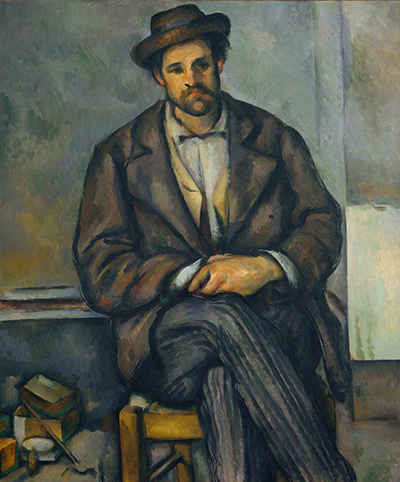Seated Peasant is an oil canvas painting that French artist Paul Cézanne did from 1892 to 1896. Cézanne loved portraits, and they became a signature of his artwork. This painting is one for the many portraits that the artist did featuring ordinary working-class people. Cézanne didn't limit his portraits to the conventions of the time.
His models didn't pose in fancy salons to showcase their prominent status. It is not clear who the subject is in Seated Peasant, but speculations have always been one of the workers at Cézanne's home. In most of his peasant portraits, the painter used the people who worked on his mother's cottage as models.
A Melancholy Peasant
The painting features a melancholic young man sitting on a cane chair. He is wearing a white dress shirt, a white string tie, a yellow vest and a brown coat. The peasant also has on a brown hat and striped grey trousers. One leg is crossed over the other, and his hands folded on his laps. Cézanne exaggerated the hands such that they seem larger than the rest of the form. The peasant is also wearing an oversized coat that makes it look borrowed. His head is tilted slightly, his lips in a tight line and a sullen look on his face. Nothing much is going on in the room. Except for the chair, a few items are on the floor next to the man.
They look like a box, two books and a few other nondescript objects. The peasant is a stoic man, and his presence oozes through the painting. In this piece, Cézanne uses a lot of browns and greys. However, he still manages to create some contrast. A dash of yellow from the cane chair brightens the grey of the trousers. On the left side of the painting, behind the man, is a white board that seems to be leaning against the wall. It contrasts sharply with the rest of the wall, which is a blend of grey and brown. The artist threw in a dash of green at the items scattered on the floor to cut through the brown shades. What results is a reserved yet balanced setting that matches the demeanour of the peasant.
The French painter had unique admiration for the working people, especially the elderly ones who stayed true to their Provencal roots. Through the latest 1800s, Cézanne painted portraits of farmhands who worked at Jas de Bouffan, his mother's house in Aux-en-Provence. It why the subject in Seated Peasant is believed to be a worker. However, he appears younger than the typical models Cézanne used. Standing Peasant and Portrait of a Peasant are two similar pieces. Metropolitan of Art currently owns the Seated Peasant.




